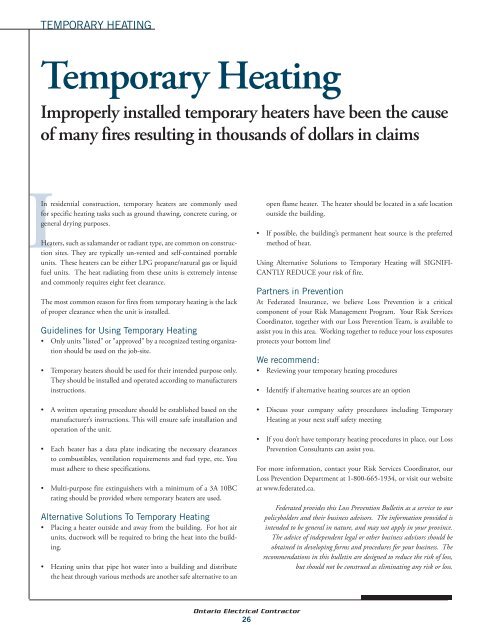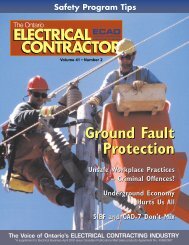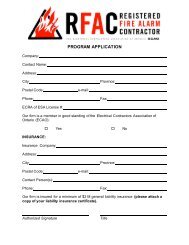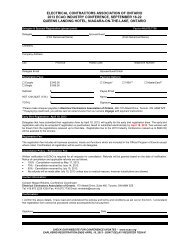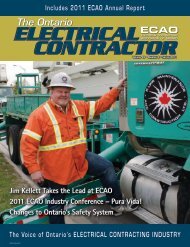Prompt Payment Legislation - Electrical Contractors Association of ...
Prompt Payment Legislation - Electrical Contractors Association of ...
Prompt Payment Legislation - Electrical Contractors Association of ...
- No tags were found...
You also want an ePaper? Increase the reach of your titles
YUMPU automatically turns print PDFs into web optimized ePapers that Google loves.
Temporary HeatingTemporary HeatingImproperly installed temporary heaters have been the cause<strong>of</strong> many fires resulting in thousands <strong>of</strong> dollars in claimsIn residential construction, temporary heaters are commonly usedfor specific heating tasks such as ground thawing, concrete curing, orgeneral drying purposes.Heaters, such as salamander or radiant type, are common on constructionsites. They are typically un-vented and self-contained portableunits. These heaters can be either LPG propane/natural gas or liquidfuel units. The heat radiating from these units is extremely intenseand commonly requires eight feet clearance.The most common reason for fires from temporary heating is the lack<strong>of</strong> proper clearance when the unit is installed.Guidelines for Using Temporary Heating• Only units "listed" or "approved" by a recognized testing organizationshould be used on the job-site.• Temporary heaters should be used for their intended purpose only.They should be installed and operated according to manufacturersinstructions.• A written operating procedure should be established based on themanufacturer’s instructions. This will ensure safe installation andoperation <strong>of</strong> the unit.• Each heater has a data plate indicating the necessary clearancesto combustibles, ventilation requirements and fuel type, etc. Youmust adhere to these specifications.• Multi-purpose fire extinguishers with a minimum <strong>of</strong> a 3A 10BCrating should be provided where temporary heaters are used.Alternative Solutions To Temporary Heating• Placing a heater outside and away from the building. For hot airunits, ductwork will be required to bring the heat into the building.• Heating units that pipe hot water into a building and distributethe heat through various methods are another safe alternative to anopen flame heater. The heater should be located in a safe locationoutside the building.• If possible, the building’s permanent heat source is the preferredmethod <strong>of</strong> heat.Using Alternative Solutions to Temporary Heating will SIGNIFI-CANTLY REDUCE your risk <strong>of</strong> fire.Partners in PreventionAt Federated Insurance, we believe Loss Prevention is a criticalcomponent <strong>of</strong> your Risk Management Program. Your Risk ServicesCoordinator, together with our Loss Prevention Team, is available toassist you in this area. Working together to reduce your loss exposuresprotects your bottom line!We recommend:• Reviewing your temporary heating procedures• Identify if alternative heating sources are an option• Discuss your company safety procedures including TemporaryHeating at your next staff safety meeting• If you don’t have temporary heating procedures in place, our LossPrevention Consultants can assist you.For more information, contact your Risk Services Coordinator, ourLoss Prevention Department at 1-800-665-1934, or visit our websiteat www.federated.ca.Federated provides this Loss Prevention Bulletin as a service to ourpolicyholders and their business advisors. The information provided isintended to be general in nature, and may not apply in your province.The advice <strong>of</strong> independent legal or other business advisors should beobtained in developing forms and procedures for your business. Therecommendations in this bulletin are designed to reduce the risk <strong>of</strong> loss,but should not be construed as eliminating any risk or loss.Ontario <strong>Electrical</strong> Contractor26


